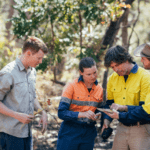Hope Jahren’s first book, Lab Girl, is a memoir about her career as a scientist from Georgia Tech (1996–1999) to Johns Hopkins (2000–2008) to the University of Hawaii (2009–2016). In engaging prose, it tells the story of how an awkward girl from Minnesota overcame numerous academic challenges (despite being a woman and having a mental illness) to become a world-renowned researcher in partnership with her senior research manager of 20 years, Bill Hagopian.
Lab Girl has received positive feedback from writers such as Cheryl Strayed (Dear Sugar, Wild) and Ann Patchett (Bel Canto, State of Wonder). It won the 2017 National Book Critics Circle Award for Memoir/Autobiography, was nominated for The Kirkus Prize 2016, and was a finalist for the 2017 PEN America/E.O. Wilson Literary Science Writing Award and the 2017 AAAS/Subaru SB&F Prize (Young Adult).
Jahren herself has been named one of Time magazine’s 100 most influential people (2016) and one of Popular Science’s “Brilliant 10” young scientists (2005). She has also been awarded three Fulbright Scholarships. As of fall 2016, she holds the J. Tuzo Wilson professorship at the University of Oslo’s Centre for Earth Evolution and Dynamics in Norway.
Hope Jahren sure can write. Not only is that the name of her blog, but it’s the truth. Have you ever heard a leaf described as “a platter of pigment strung with vascular lace,” or read that during photosynthesis, “…buzzing electrons line up into an unfathomably long chain and pass their excitement one to the other, moving biochemical energy across the cell to the exact location where it is needed,”? This is the kind of language that makes Jahren’s science exciting and accessible and keeps you reading to the end.
Jahren learned about science as a child by hanging out in her father’s chemistry lab in the evenings where she “transformed from a girl into a scientist, just like Peter Parker becoming Spider-Man, only kind of backward.” Her interest in plant biology was likely piqued by the family’s garden. “My first memory of our garden is…how it sounded. It might strike you as fantastic, but you really can hear plants growing in the Midwest.” And if you’re wondering about her writing ability, Jahren and her mother read many books together as her mother completed an English literature degree by correspondence.
Jahren found that science was a good fit for someone with her “inability to let things go coupled with [a] tendency to overdo everything.” Given her quiet joy in her father’s lab as a child, she sees the research lab as a sanctuary. “My lab is a place where my guilt over what I haven’t done is supplanted by all of the things that I am getting done…My lab is like a church because it is where I figure out what I believe…the lab has become the place where I can be the real me.”
While the book is a good primer on plant biology, it focuses largely on Jahren and Hagopian’s relationship. They first meet during her PhD, when she is a teaching assistant for his undergraduate soils class. She sees him as a brother, with the two of them acting like “12-year-old fraternal twins,” united against the world. He joins her lab when she gets her first position at Georgia Tech; Jahren secures the funding while Hagopian gets the experiments to work. Hagopian then moves with Jahren to each new university. When Jahren’s husband, Clint, arrives on the scene there’s a momentary awkwardness, but Hagopian remains like a brother to Jahren and later becomes a beloved uncle to her son.
Jahren’s story is engrossing, with a well-paced and well-structured narrative that maintains forward momentum and keeps you reading to find out what happens next. I also appreciated her infectious passion for and fantastic ability to clearly communicate plant science. However, the story of Jahren and Hagopian’s travels to three universities also exposes serious systemic issues in academia. In fact, this is one of the first books I’ve read that lays bare the roadblocks in the life of an academic scientist: the workload, tight funding and, in Jahren’s case, being female and having a mental illness.
One of the key issues that offsets some of Jahren’s pure joy of doing science is academia’s culture of overwork. I suspect Jahren’s description of endless hours spent in the lab (she even sets aside Wednesdays as “all-nighters” so that she can get ahead) and no personal life will turn off readers who might otherwise be interested in science. Indeed, Jahren did have a grad student quit, “sneering on her way out that she didn’t want a life like mine.”
A professor’s workload, particularly when starting out, is quite heavy, and Jahren is ambitious. Ambition and workaholism often go hand in hand, as writer Pam Houston explains, “Work is my pleasure, my refuge, my comfort, my challenge, my definition…When the work is going well, or even if it’s just going, it is a hand on my shoulder assuring me that everything is going to be okay.”
One of the biggest tasks on Jahren’s plate is finding funding for everything from lab materials to Hagopian’s salary. Despite giving her all to the job, Jahren hits a low point just before they leave Georgia Tech; Hagopian is living out of the lab, and they’re pilfering equipment from the student labs to do their research. By the time they reach the University of Hawaii, however, the university provides secure funding for Hagopian, and many of Jahren’s grants are funded.
This seesaw of research funding—the constant worry about whether or not your lab will fold—is problematic for many academic scientists, and is a serious distraction from doing research. As Jahren notes, once the stress of finding funding subsides she’s able to focus on research that starts to pay dividends, she begins to win awards, and she rediscovers her love of teaching.
While most lab scientists struggle with funding, it’s important to note that Jahren’s story is not that of the average scientist. This is in large part due to the main reason she wrote this book: Bill Hagopian. Most scientists don’t have the same lab manager for 20 years—particularly one willing to not only put up with poor initial working conditions, but also to travel with them to three different universities. By working so closely together, they likely have much greater research output relative to labs without a “Bill.” Jahren’s book emphasizes the benefits of scientists building strong, personal relationships with close colleagues to push the limits of their science.
Beyond the issues associated with a heavy workload and tight funding, the book also lends itself to the discussion of role models in science. Given the underrepresentation of women in science, women academics often become role models for female students who are making difficult decisions about career and life choices. With this book, Jahren has likely become a role model to many of her readers.
But putting Jahren on a pedestal as a role model runs the risk of creating a Marie Curie situation. This is when we only recognize uber-successful women in science, while those who are less accomplished remain in the shadows. Recently on Twitter, Dr. Lucia Lorenzi suggested that it’s time academia recognize that not all academics are exceptional, and that it’s okay to be mediocre.
Additionally, while most of the discussion about role models focuses on the positive aspects, we often lose sight of the fact that not everyone wants to be a role model. For Jahren, for example, it seems that her relationship with students is more of a burden than it is mutually beneficial. One line that jumped out at me was that she “wouldn’t hire anyone who didn’t care as deeply about the work as [she] did [herself].” We all know that students that committed are hard to find, and it’s more likely you’ll have students who can do the work, but just aren’t as personally invested in it.
Other readers have questioned the methods used by Jahren and Hagopian when working with new students, mentioning one initiation process in particular. The student is tasked with carefully labelling hundreds of glass vials. Once they finish, Jahren and Hagopian discuss the rationale behind the experiment for which the vials would be used. Ultimately this discussion culminates in all of the labelled vials being tossed in the garbage, as the project has to be rethought from scratch. For Jahren, “any sign that the newbie regarded his or her time as of any value whatsoever was a bad omen.” Dr. Ambika Kamath writes about this particular approach: science will toughen you up enough on its own, with or without extra tough love from a supervisor.
Jahren’s blog and the op-ed she’s written for outlets like The New York Times cover sexism in academia in quite some detail, so it’s not surprising that she decides to leave much of this topic out of Lab Girl. In the book, Jahren describes sexism as “the cumulative weight of constantly being told that you can’t possibly be what you are.” She applied for professor jobs in the third year of her PhD because she “[knew she’d] have to be at least twice as proactive and strategic as [her] male counterparts.” And she says of the all-male crew she worked with in the fossil forest on Canada’s Axel Heiberg Island, “Look at those guys. I’m going to do this job for thirty more years, work as hard as any of them, accomplish just as much or more, and not one of them will ever look me straight in the eye like I belong here.”
Jahren also writes quite selectively about her mental illness. Most of it is summed up in her descriptions of a psychotic episode triggered by corticosteroid injections required to treat poison ivy and the problems she faced during her pregnancy when she was unable to take her medications for bipolar disorder. While it’s obvious that the book is meant to focus largely on Jahren and Hagopian’s relationship, it would have been helpful to know a bit more about how Jahren copes with her mental health challenges on a day to day basis.
Overall, I recommend the book given Jahren’s excellent writing and passion for science in general and plant biology in particular. It’s also a unique look at a long-term research relationship that has survived the ups and downs of the academic system. However, as Jahren’s story shows, academia can be a hindrance rather than a help in doing great science. Jahren has risen to the top through ambition, perseverance, and the help of Bill. And she wouldn’t have it any other way: “…because I am a female scientist, no one knows what the hell I am, and it has given me the delicious freedom to make it up as I go along.”




